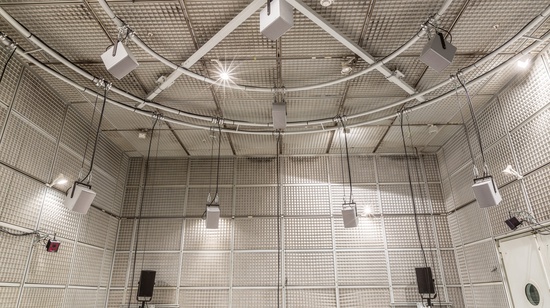L'Unité mixte de recherche Sciences et technologies de la musique et du son (UMR STMS) a l’immense plaisir de voir récompensé par un Cristal CNRS le travail de Thibaut Carpentier, ingénieur d’études dans l’équipe Espaces acoustiques et cognitifs depuis 2009. Les outils qu’il a développés et diffusés sont la vitrine technologique de l’équipe et de l’UMR. Ils contribuent de manière essentielle à l’excellence de notre laboratoire par leur rayonnement exceptionnel auprès des communautés artistique, scientifique et industrielle.
Les enjeux
 La spatialisation sonore recouvre l'ensemble des méthodes de capture, de reproduction ou de synthèse des dimensions spatiales d'une scène sonore. Les techniques de spatialisation du son visent à créer l'illusion que des sons proviennent de diverses directions dans un espace qui a une signature acoustique propre et ainsi à organiser des scènes sonores en trois dimensions. Elles connaissent aujourd'hui un essor important. La mise en scène des sons dans l’espace est devenu un aspect incontournable de la création musicale contemporaine. Mais l'ajout d'une composante sonore spatialisée est également un enjeu industriel au cinéma, dans les jeux vidéo et les applications de réalité virtuelle ou augmentée pour accroître le réalisme et la sensation d'immersion de l’auditeur.
La spatialisation sonore recouvre l'ensemble des méthodes de capture, de reproduction ou de synthèse des dimensions spatiales d'une scène sonore. Les techniques de spatialisation du son visent à créer l'illusion que des sons proviennent de diverses directions dans un espace qui a une signature acoustique propre et ainsi à organiser des scènes sonores en trois dimensions. Elles connaissent aujourd'hui un essor important. La mise en scène des sons dans l’espace est devenu un aspect incontournable de la création musicale contemporaine. Mais l'ajout d'une composante sonore spatialisée est également un enjeu industriel au cinéma, dans les jeux vidéo et les applications de réalité virtuelle ou augmentée pour accroître le réalisme et la sensation d'immersion de l’auditeur.
Cette thématique scientifique est le domaine de recherche de l’équipe Espaces acoustiques et cognitifs qui héberge dans notre laboratoire le travail de Thibaut. De nombreuses avancées fondamentales ont eu lieu cette dernière quinzaine d’années mais de la compréhension des paramètres pertinents du son spatialisé à l’utilisation effective de ces connaissances dans des applications « grand public » et convaincantes, il y a un fossé énorme que Thibaut a contribué à combler, à un niveau international, en développant des outils informatiques permettant de placer et d'animer des sources sonores de façon arbitraire, dans n'importe quelle direction, et ainsi de créer ou recréer de manière souple, efficace et expressive une scène sonore 3D.
Pourquoi
Arrivé en 2009, Thibaut est le développeur principal et chef du projet SPAT et de la station logicielle de mixage et de post-production 3D Panoramix. D’abord plateformes de recherche intégrant et validant les avancées les plus récentes, elles ont démontré leurs qualités et leur maturité dans des créations de musiques contemporaines marquantes répondant aux demandes de toute une communauté d’artistes et de créateurs autour des technologies du son spatialisé.
Les systèmes qu’il a développés suscitent alors un très vif intérêt dans la communauté audionumérique professionnelle internationale où ils ont reçu plusieurs distinctions marquantes (best plug-in Resolution Awards 2011, RockoN Tech Award au NAMM Show 2017, Prix du Public au SATIS 2017 dans la catégorie Post-production).
Aujourd’hui, ces outils innovants sont largement diffusés au niveau international (15000 téléchargements depuis 2014) et intégrés dans de nombreux studios de production audionumérique (France Télévisions, BBC, Radio France, Festival de Salzburg, etc.). Répondant également à la diversité des formats de diffusion et des usages, ils ont donné lieu à plusieurs licences ou développements conjoints avec des industriels en France et à l'étranger (Arkamys, L-Acoustics, Flux, Univers Sons, Orange Labs, etc.). Ces librairies ont également trouvé leur application dans le domaine des neurosciences et de la santé : cognition spatiale en microgravité (vols zéro-G) et traitement des acouphènes (Hôpital Georges Pompidou).
Comment
Il est difficile de rendre compte de la variété de compétences que Thibaut a dû réunir pour cette « success story » : expertises logicielles, traitement du signal, acoustique physique, psycho-acoustique, informatique temps-réel, musique… Les outils qu’il a proposés et développés permettent de s’abstraire de la complexité des formats de restitution sonore 3D. Les normes qu’il a contribué à faire adopter permettent aujourd’hui à différents systèmes de dialoguer. Les techniques de filtrage temps-fréquence-espace appliquées à la réverbération ont permis des rendus sonores plus réalistes. La qualité technique de ses réalisations rend aujourd’hui possible la manipulation de plusieurs centaines de canaux audio sans problème sur un ordinateur individuel et répond aux demandes de créateurs contemporains les plus exigeants.
Photo : Studio 1 © Philippe Barbosa



 La spatialisation sonore recouvre l'ensemble des méthodes de capture, de reproduction ou de synthèse des dimensions spatiales d'une scène sonore. Les techniques de spatialisation du son visent à créer l'illusion que des sons proviennent de diverses directions dans un espace qui a une signature acoustique propre et ainsi à organiser des scènes sonores en trois dimensions. Elles connaissent aujourd'hui un essor important. La mise en scène des sons dans l’espace est devenu un aspect incontournable de la création musicale contemporaine. Mais l'ajout d'une composante sonore spatialisée est également un enjeu industriel au cinéma, dans les jeux vidéo et les applications de réalité virtuelle ou augmentée pour accroître le réalisme et la sensation d'immersion de l’auditeur.
La spatialisation sonore recouvre l'ensemble des méthodes de capture, de reproduction ou de synthèse des dimensions spatiales d'une scène sonore. Les techniques de spatialisation du son visent à créer l'illusion que des sons proviennent de diverses directions dans un espace qui a une signature acoustique propre et ainsi à organiser des scènes sonores en trois dimensions. Elles connaissent aujourd'hui un essor important. La mise en scène des sons dans l’espace est devenu un aspect incontournable de la création musicale contemporaine. Mais l'ajout d'une composante sonore spatialisée est également un enjeu industriel au cinéma, dans les jeux vidéo et les applications de réalité virtuelle ou augmentée pour accroître le réalisme et la sensation d'immersion de l’auditeur.